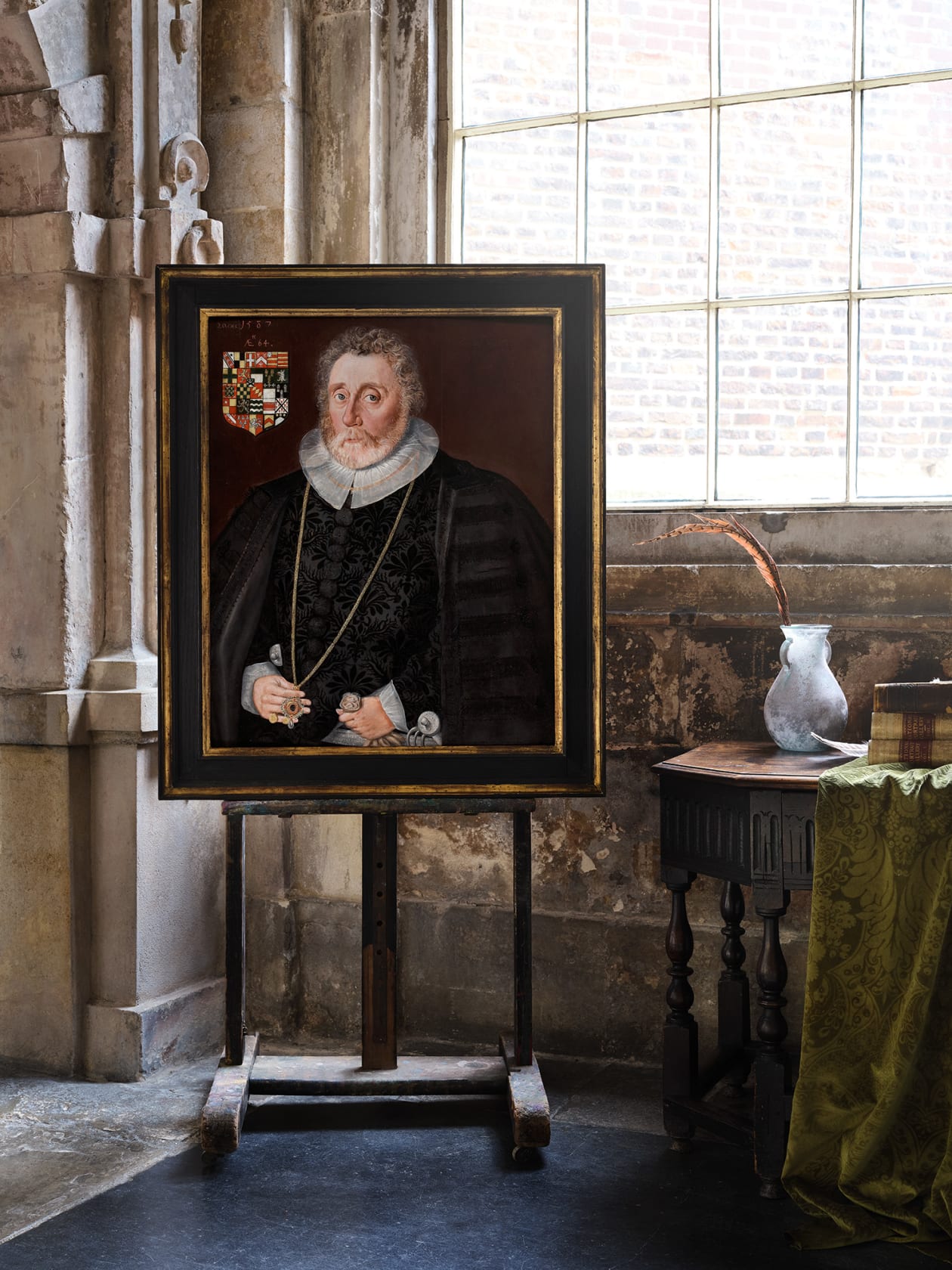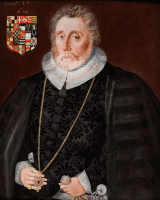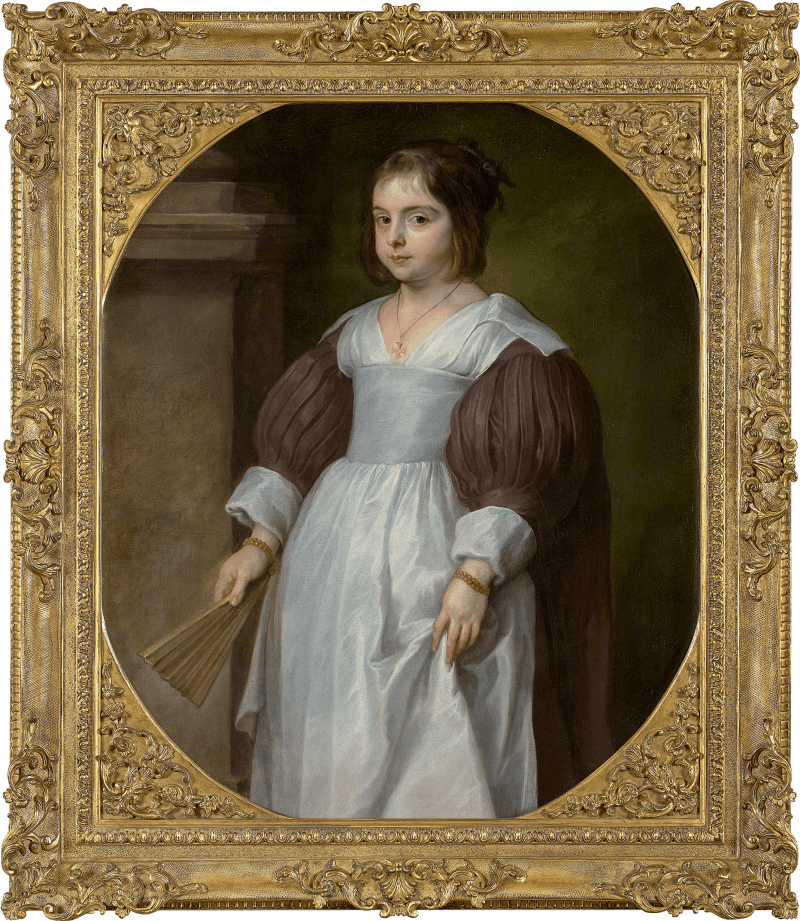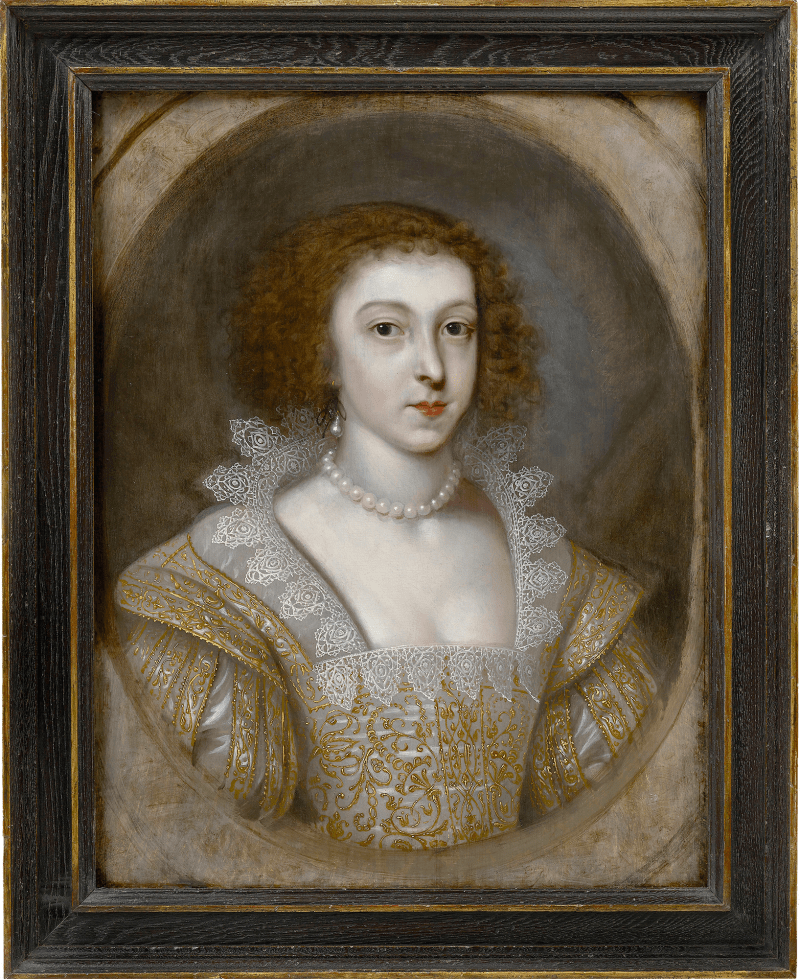This characterful portrait was painted in 1587 by Robert Peake, one of the leading court painters of the late-Elizabethan and Jacobean periods. Its robust and arresting individuality illustrate some of the reason behind the success of an artist who enjoyed the highest level of patronage, providing likenesses of the royal family as painter to Henry Frederick, Prince of Wales, and later as Serjeant Painter to James VI & I. Its captivating facial realism also represents the foundations of an English school of direct portrayal that can be seen continuing through the work of such artists as Dobson, Hogarth and Reynolds in the next two centuries.
Over the passage of time a sitter’s identity can often be forgotten, and even the most important figures of the Elizabethan age can be found languishing under mistaken identities. Thus was the case with this portrait until recent research returned Richard Wingfield his correct identity.
It was highly unusual for artists from this period to...
This characterful portrait was painted in 1587 by Robert Peake, one of the leading court painters of the late-Elizabethan and Jacobean periods. Its robust and arresting individuality illustrate some of the reason behind the success of an artist who enjoyed the highest level of patronage, providing likenesses of the royal family as painter to Henry Frederick, Prince of Wales, and later as Serjeant Painter to James VI & I. Its captivating facial realism also represents the foundations of an English school of direct portrayal that can be seen continuing through the work of such artists as Dobson, Hogarth and Reynolds in the next two centuries.
Over the passage of time a sitter’s identity can often be forgotten, and even the most important figures of the Elizabethan age can be found languishing under mistaken identities. Thus was the case with this portrait until recent research returned Richard Wingfield his correct identity.
It was highly unusual for artists from this period to inscribe the name of the sitter on the front of a portrait – Mary Potter by the Master of the Countess of Warwick being a rare example, and often only the date and the sitter’s age were stated. The majority of encountered inscriptions from this period were added by later generations of the same family and were often applied in error, causing considerable confusion. These misidentifications were often accidental but were sometimes done with the intention to deceive – it is common to see portraits of less glamorous ancestors ‘upgraded’ to likenesses of family members with greater historical significance.
Until recently, an inscription in the upper right corner of this portrait identified the sitter as Humphrey Wingfield, a prominent lawyer and legal advisor to Henry VIII, and it was reproduced as such in Roy Strong’s seminal work The English Icon.[1] However, recent research into the armorial bearings shown in the upper left corner of the portrait (Fig.1) reveals the sitter is, in fact, Humphrey’s great-nephew Richard Wingfield, a wealthy politician and landowner from Suffolk.
There are two key elements within the arms which confirm the identity of our sitter. In the furthest upper left section of the arms (the 1st quarter) the arms of the Wingfield family show a small black star (or ‘mullet’) in the upper right. The mullet is a ‘cadency’ mark used to differentiate between males of the same armigerous family and in this instance indicates our sitter was the third son. This corresponds with several reliable documents from the period which state Richard was the third son of Sir Anthony Wingfield and his wife Elizabeth (née Vere).[2] Furthermore, we know that Richard married Mary Hardwick, daughter and co-heir of Sir John Hardwick, hence the inclusion of the Hardwick arms as an ‘escutcheon of pretence’ towards the centre. The reason the Hardwick arms is floating and not incorporated into the shield is because Richard would never have owned his wife’s arms, and thus they could not be passed on to any sons that were not hers in the event of her death.
Richard was born into a wealthy and respectable Suffolk family. His father Anthony was a distinguished military commander who was appointed Privy-Councillor and Vice-Chamberlain to Henry VIII in 1539.[3] Two years later he was made a Knight of the Garter, and in 1551-52 held the position of Lord-Lieutenant of Suffolk, which made him responsible for managing the county’s military forces on behalf of the king. His mother was Elizabeth, daughter of Sir George de Vere and sister and co-heir of John de Vere, 14th Earl of Oxford.
Following in his father’s footsteps, in 1559 Richard was elected MP for Orford in Suffolk, a position he held again later in 1586 and 1589. His wealth and status within Suffolk secured his appointment as Justice of the Peace in around 1559 which further bolstered his influence. In around 1550 Richard married Mary Hardwick, who came from a moderately prosperous Derbyshire gentry family; her sister was Elizabeth, more familiarly known as Bess of Hardwick, who later became one of the wealthiest and most prominent women of the Elizabethan age. Richard and Mary had three sons and two daughters together and following Mary’s death Richard married a lady named Joanna, widow of John Harbottle of Crowfield. Wingfield appears to have taken his judicial responsibilities within the county seriously, and in 1582 he supported a petition from Puritan justices to the Privy Council claiming unnecessary harshness of assize judges (judges sent from London to preside over trials of serious offenders in the counties) against radical preachers.
In the present portrait Richard is shown towards the end of his life, bedecked in the various trappings of success.[4] He is shown wearing a black silk doublet with repeated patterns, indicating a woven design. Black was the most expensive dye during the Elizabethan period and was a key signifier of wealth and prosperity in portraiture. At the lower centre of the garment we see a pronounced peascod belly protruding over a silver sword belt. The padded overhanging of an almost pointed form was fashionable in the 1580s, as were the large spherical buttons worn on the doublet. The short Spanish-style cloak is also black, lined with shiny satin and embellished with broad braid which helps to create the wide, swaggering silhouette which was in vogue during this decade. The sumptuous black fabric is further emphasised by the fine linen falling bands at the neck and the simple see-through cuffs.
In his left hand he holds a pair of leather gloves and with his right hand he proudly shows the viewer an exquisite gold pendant – possibly a miniature case – decorated with enamel and precious stones, from which hangs a large pearl (Fig.2). At the centre of the pendant there is a cameo of a head in profile. During the Elizabethan period the ancient art of gem engraving was revived and elaborate jewels such as this were worn as indicators of affluence and erudition. The jewel shown here was clearly of significance to Wingfield and could possibly have been given to him by an influential friend or patron in recognition of loyal service. It is sometimes stated that Wingfield was a Gentleman Usher to Elizabeth I, a position which would certainly have warranted the gift of a fine pendant such as this, however, this cannot be corroborated and his name may have been confused with another Richard Wingfield who was active at court around the same time.[5] The date ‘20 DEC’ shown in the upper left was applied by a later hand but may possibly relate to a specific event which occasioned the presentation of the pendant, however, no such event has so far come to light. Beside the pendant, on his little finger, Richard wears two signet rings (Fig.2). The smaller ring shows the arms of the Wingfield family in reverse and would have been used for sealing formal documents. The larger ring shows a pair of wings – in reference to the family name – and was perhaps used for sealing less important documents or private letters.
Richard died in 1591 and his will indicates he was a man of considerable wealth with extensive land holdings – presumably through his first wife – in Derbyshire, Herefordshire, Staffordshire, Warwickshire and Worcestershire. His land and manors in Suffolk were left to his sons, and his second son John also received a share of manors at Chillesford where Richard bred horses and sheep.[6]
Peake was born into a prosperous Lincolnshire family and is first recorded by name on 30 April 1565 when he enrolled as an apprentice to the London goldsmith Laurence Woodham.[7] In 1576 he became a freeman of the London Goldsmith’s Company and over the next three years was employed as a painter for Office of Revels – a department of the Royal Household responsible for the staging of events such as banquets, masks, plays and dances. When this work was painted Peake was living in Green Dragon Court, in the Holborn Cross precinct of St Sepulchre-without-Newgate in the City of London.
This work is one of the earliest portraits attributed to Peake’s hand and fits stylistically into a group of portraits he painted in the late 1580s and early 1590s, including those of Arthur, Lord Grey de Wilton (1587), Sir Thomas Crompton (1590) and an unknown gentleman (c.1585-90). These works can be distinguished by their intense realism and smooth, confident application of paint, showing a distinct departure from the more precise, linear approach taken by the artists of the previous generation such as The Master of the Countess of Warwick and George Gower.
The process of identifying early works by Peake is made possible due to the survival of a touchstone portrait in the collection at the Yale Center for British Art which is dated 1599 (though later changed to 1593) and inscribed on the reverse ‘M.BY.RO./PEAKE’ with A and K in monogram (Fig.3). As discussed in the preceding essay by Edward Town and Jessica David, the present portrait of Richard Wingfield shares several similarities with the Yale work, most notably in the loose handling and direct, watery gaze which heightens the individuality of the sitter’s face.
[1] Strong, R. (1969) The English Icon: Elizabethan and Jacobean Portraiture. London and New York: Paul Mellon Foundation, p. 229.
[2] Metcalfe, W.C. (ed.), (1612) The visitations of Suffolk made by Hervey, Clarenceux, 1561, Cooke, Clarenceux, 1577, and Raven, Richmond Herald, 1612, with notes and an appendix of additional Suffolk pedigrees. Exeter: William Pollard, pp. 175-6.
[3] Swales, R.J.W. (1982) The History of Parliament Online. [online] Available at: http://www.historyofparliament... [accessed: 19 Feb. 2021].
[4] We are grateful to Jacqui Ansell, Senior Lecturer Christie’s Education, for her assistance when researching the costume.
[5] Swales, (1982) History of Parliament.
[6] Will of Richard Wingfield. 2 May 1588. National Archives PROB 11/78, ff. 49-50.
[7] The most up to date biography on Peake is Karen Hearn’s entry in the Oxford Dictionary of National Biography (2008).

















